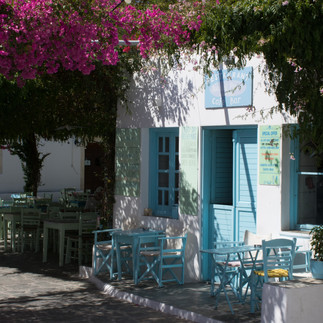How do you tell the difference between Greek moonshine and water?
- halkidikiskipper
- Sep 20, 2022
- 3 min read
The answer to that question is that by looking on the supermarket shelf, you can't, but more of that in a minute.
We're now on the delightful island of Φολέγανδρος (Folegandros, but I really love to see it in Greek) and if you saw my last blog you'll know we got here on the sooper dooper small Seajet Hydrofoil that I'm keen to become the driver of. Seajet have two, and they are normally whizzy, but they do have a disadvantage that, by ferry standards, they are a bit on the diddy side. This makes them much much more susceptible to poor sea state, which our journey to Folegandros proved. It didn't look that rough, but Superjet (the name of the Seajet ferry we were on) was slowed from 35 knots to 19 knots, was bouncing all over the place and felt anything but 'Super'. The end result was that before long a Seajet steward appeared with extra sick bags, which were very much needed, and the journey time was extended by nearly 2 hours. Very fortunately, being the experienced mariners we are, we had taken the appropriate drugs (always happy to provide advice on this subject) and weren't sick. I didn't take any pictures of the inside of Superjet which certainly wasn't super either.
Before I get onto Φολέγανδρος I'll share with you something I've been meaning to share for a while, that is the subject of a local fire water which anywhere else would be called moonshine, but in Greece it's anything but illicit. It's made everywhere and is perfectly legal, it's even sold in most supermarkets. It has different names depending on where you are, in the north it originates from Macedonia (the region of Greece, not the country) and is called Tsipouro (pronounced 'chipero'), in the south it originates from Crete and is called Tsikoudia or Raki (same name, but not to be confused with Turkish Raki).
It's a kind of un-aged Brandy made from the left overs of the wine press, akin to a rough Grappa if you've ever had it. One assumes that someone at some point made wine and thought 'what shall we do with the left overs? I know let's distil it and make some fire water'. It's clear, can have aniseed added and is between 40% and 50% proof. It's normally sold in the super market in un-labelled water bottles so you've no idea who made it or what's in the bottle, but it will get you drunk cheap! The only clues as to what it is are that it'll be on the booze shelf (probably) and has no label (probably). And, unbelievably it's legal! Some piccies below of the bottle which we've sampled and is about to go down the sink. We bought a small bottle for 3.90 Euros, but it also comes in handy 1 1/2 litre bottles for not much more money.
I'm guessing that most readers of this blog won't know much about Folegandros, which is a small island hidden in the outer reaches of the Cyclades group of islands. It's a fair way from Athens in the north and probably because it's fairly isolated is poorly served by ferries. Historically, because of it's isolation, it was used to house political exiles from Crete as far back as ancient Greece and as recently as 1970. Folegandros can never have been an easy island to live on, and certainly tourism would have been impossible without water tankers delivering fresh water and more recently a desalination plant. Indeed until the 70's there wasn't even a road connecting the port with the rest of the island. Folegandros has a population of about 750, most of whom live either in the port, Karavostasis, the main village, Chora (which just means village), and two other tiny settlements, Ano Meria and Agali.
Why are we here on Folegandros? The two piccies below should say it all, the first of which is the view from our balcony.


The church of Panagia is in fact a monastery, which with the path leading to it provides a stunning spectacle stretching high above Chora. Apparently the sunset from the monastery is also stunning, which we'll be sure to see before we leave. The second picture shows Folegandros Chora which is perched at the top of a 200M sheer cliff. It's been described as a mini Santorini but I don't think that does it justice. And for the icing on the cake Folegandros Chora is as cute as a button, is probably the friendliest place we've been on this trip (and that's saying something) and has such a nice atmosphere, in the daytime and evening. Here's a few random piccies of Chora and the path up to the monastery.
We hope Folegandros remains difficult to get to and off the main Greek island tourist itineraries. We hope it stays just the way it is.
More soon,
Yamas!










































Comments